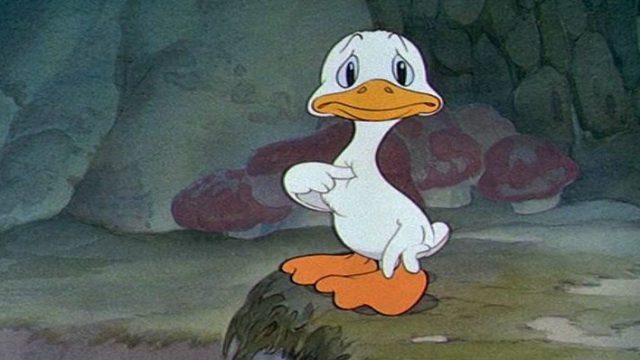Over the course of ten years, from 1929’s “The Skeleton Dance,” Disney produced exactly 75 Silly Symphonies. This, released on April 7 of our Year of the Month, was the last. It was a remake of an earlier, B&W version, made in 1931. It would win Best Animated Short (Color) over a particularly weird slate. (“The Pointer,” a Mickey Mouse and Pluto cartoon; “Peace on Earth,” an MGM cartoon about the annihilation of humanity; and “Detouring America,” an occasionally racist travelogue by Tex Avery for Warners.) It is one of seven in the series to have won the Animated Short award. I’m honestly convinced it’s even the best of the Disney shorts nominated that year, but still.
The story is, of course, a familiar one. A drake is pacing around as a stereotypical expectant father, waiting for his hen to hatch her eggs. When they do, in addition to the chorus of ducklings, there is one unexpected honk and a chick that does not resemble the others. Immediately, the ducks begin fighting—in Clarence Nash duck, not words—and abandon the chick. The ducklings follow their parents, and the remaining chick is left alone. He wanders for a bit, miserable, until a chorus of honks like his own draw his attention.
Cygnets are not actually, in my opinion, notably ugly, which is why the abbreviation of this cartoon works better than Hans Christian Andersen’s original version. They’re notably larger than ducklings, I believe, and certainly they look different than ducklings, but Andersen has his cygnet wandering for a solid year, repeatedly being called ugly by everyone and everything it encounters until it discovers it’s grown into a swan. (Spoilers for a 181-year-old story, I guess?) This one is still a baby when it is found by what appears to be its actual birth family.
How did the swan egg get into the duck nest in the first place? The drake implies he knows in this version. Obviously it’s unspoken, since it’s just random quacking noises, but he’s definitely accusing the hen of having an affair. (All ducks, geese, and swans are members of the family Anatidae; swans are exclusively of genus Cygnet and can’t interbreed outside the genus, one assumes, though biology is weird enough that I’m not making any definitive statements, not being an ornithologist.) However, biology is irrelevant here. The cygnet is fully swan. Somehow, in both story and short, a swan egg got into a duck’s nest.
Still, there’s a reason Stitch would read from the storybook of this, in Lilo and Stitch. The art is unmistakable. The story is as appealing to generations, including a small, cute, fuzzy alien abomination, as it was to its author, the bisexual chaos demon who always felt himself an ugly duckling as well. For getting on for two hundred years, we’ve loved the idea that there is a place for us where we truly belong. These days, we’re better at making our own, but either way, we need what we need.
Help me get what I need by contributing to my Patreon or Ko-fi!


